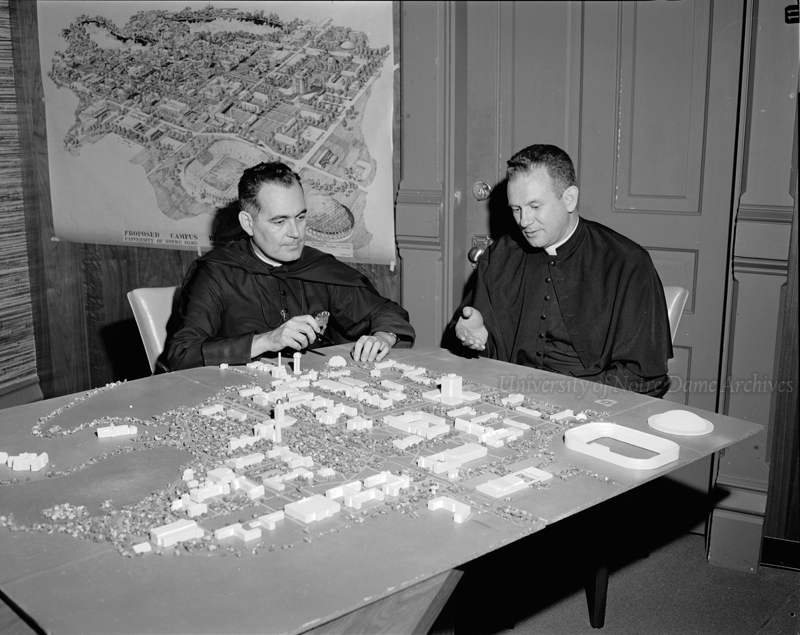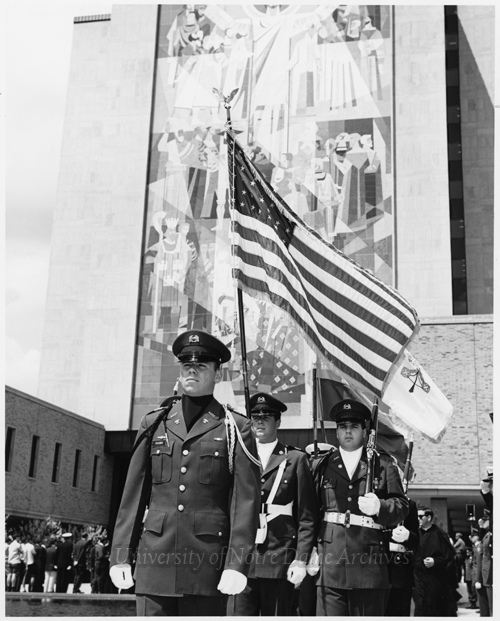 Caption
Caption
Source: University of Notre Dame Archives.
The Library: Dedication
Dedication Ceremony
The two-day program began on Wednesday, May 6, with a special symposium on the Person in the Contemporary World, held in the library auditorium. The day ended with a performance by the New York Pro Musica Motet Choir at the Stepan Center and a University Theatre production of My Fair Lady at Washington Hall.
Although strong winds lifted the banner, exposing the tower a day ahead of time, nearly 5,000 gathered on the south lawn of the library on May 7, 1964 (Ascension Thursday) for the Dedication Ceremony and formal unveiling of the 11-story mural. The campus community, alumni, friends, as well as donors and representatives from over 200 colleges and universities and societies were present. The crowd gathered beyond the rectangular reflecting pool, which sits in front of the courtyard of the library.
The mural, a beautiful stone mosaic, stood before them, the larger-than-life, gleaming gray and white-clothed resurrected Christ in front of the cross, with golden halo, his arms outstretched to the sky, and his hands extended as though giving a blessing. Encircling him, a procession of 50 saints and scholars of distinct periods, from Old Testament figures, including King David (the only one other than Christ named in the mural), to ancient classicists, to the apostles and Christians of the early Church and beyond.
The mural represents Christ, the Apostles, and individuals from the Byzantine Era, the Renaissance Era, the Eastern World, Prophets of the Old Testament, the Medieval Era, Ancient Classic Cultures, the Age of Science and Exploration, and Christians of the Early Church. There are young and aged, simply and ornately dressed, all miniatures beside the towering Christ.
The mural is a portrayal of the following verses from the first book of John:
In the beginning was the Word:
the word was with God
and the Word was God.
He was with God in the beginning.
Through him all things came to be,
not one thing had its being but through him.
All that came to be had life in him.
And that life was the light of men,
a light that shines in the dark,
a light that darkness could not overpower.(1 John 1:1-5)
Light shines on and emanates from Christ, touching the various groups. And light beams cut across the image from different angles. What appears from a distance as a simple, monochromatic work, more closely reveals a beautiful variety of earth tones, solid and multi-colored stones pieced together, mostly browns and grays, with accents of varying hues of yellow, orange, green, and blue. Pieces of Brazilian gold granite, which make up Christ's halo as well as other ornamental details, such as crowns, scepters, and David's lyre, glisten in the sun. According to Pioneer Magazine, Sheets' idea in designing the piece was that "changing sunlight and atmospheric conditions would create a constantly shifting visual impression of the mural as rays of light beam on the granite." Smooth curves soften the largely angular figures. And delicate lines chiseled into the granite create additional detail.
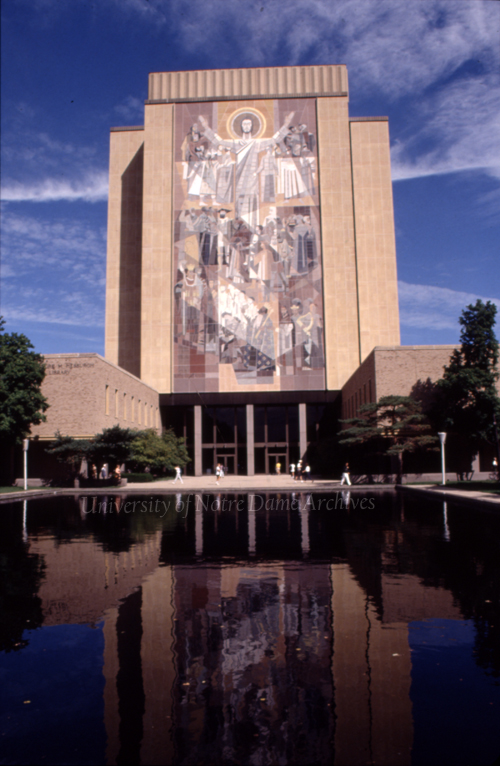
Source: University of Notre Dame Archives.
The ideal vantage point according to Sheets is the spot just beyond the reflecting pool, where a plaque stands. The three-part plaque names the donors, Mr. and Mrs. Howard V. Phalin, and includes a diagram and key, and an essay by Father Charles E. Sheedy, C.S.C., who had been asked by Father Hesburgh to explain the mural.
From the symbol of all Christianity, the cross, emerges the figure of Christ, the greatest of teachers. He, the Word of Life. The only begotten of the Father was from the beginning, with Father and Holy Spirit, in eternal divine life. Became man of the Blessed Virgin, He was seen and looked upon by human eyes and His voice was heard upon the earth. Loving ears listened to His words, and minds were inspired to remember and to note them down, and the ineffable New Testament took shape: the deeds and words of Christ, the primary document of Christian wisdom, the word of life, and of life-giving truth.
With Him in spirit are gathered the saints, the scholars, the scribes, and the teachers stretching through time, who have dedicated themselves to the preservation of truth, the Word of Life, and the preparation of men's minds to receive the truth. Their knowledge, their thoughts, their written word, which through the ages have illuminated and enriched the understanding of their own and succeeding generations, is the treasure house of knowledge housed within the walls of this structure.
The natural richness and subtlety of the stone, as well as its permanence, make it a fitting material to emphasize the grandeur, complexity, and timelessness of man's search for the truth. The truth, which is serenely and eternally possessed in the divine Person of the Word.
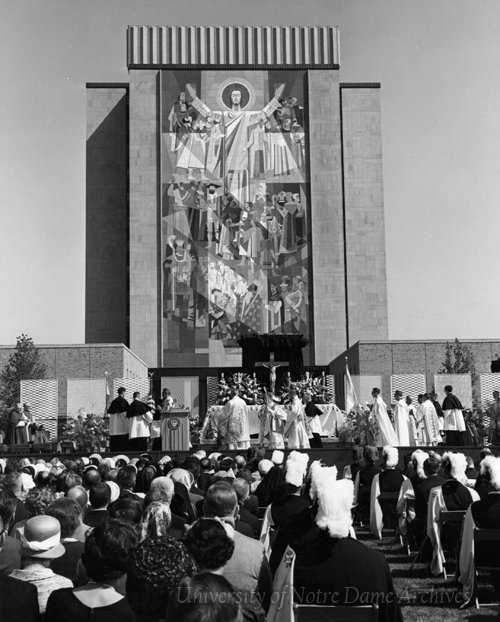
Source: University of Notre Dame Archives.
A solemn Mass was celebrated following the formal unveiling of the mural. Eugene Cardinal Tisserant (Dean of the Sacred College of Cardinals) and Albert Cardinal Meyer (Archbishop of Chicago), presided along with Father Hesburgh and several Holy Cross priests. The Notre Dame Concert Band, Glee Club, and Moreau Seminary Choir provided music for the Mass. And a special blessing from Pope Paul VI, addressed to Father Hesburgh, was read. In part it said:
To Our beloved son, Theodore M. Hesburgh, C.S.C., President of the University of Notre Dame, . . .
We pray that this additional repository of wisdom and knowledge may serve as a valuable instrument in the pursuit of truth and the defense and development of faith. . . .
. . . We invoke upon the University of Notre Dame an abundance of illuminating Divine graces.
Pope Paul VI
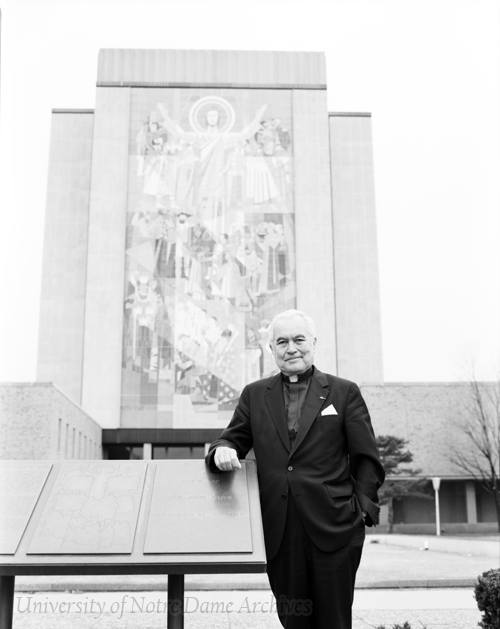
Source: University of Notre Dame Archives.
The third highlight of the day was an academic convocation on the library mall, at which 25 men and women received honorary doctorates, including the artist Millard Sheets. The South Bend Tribune hailed this Ascension Thursday as "one of the proudest days in the history of the University of Notre Dame."
